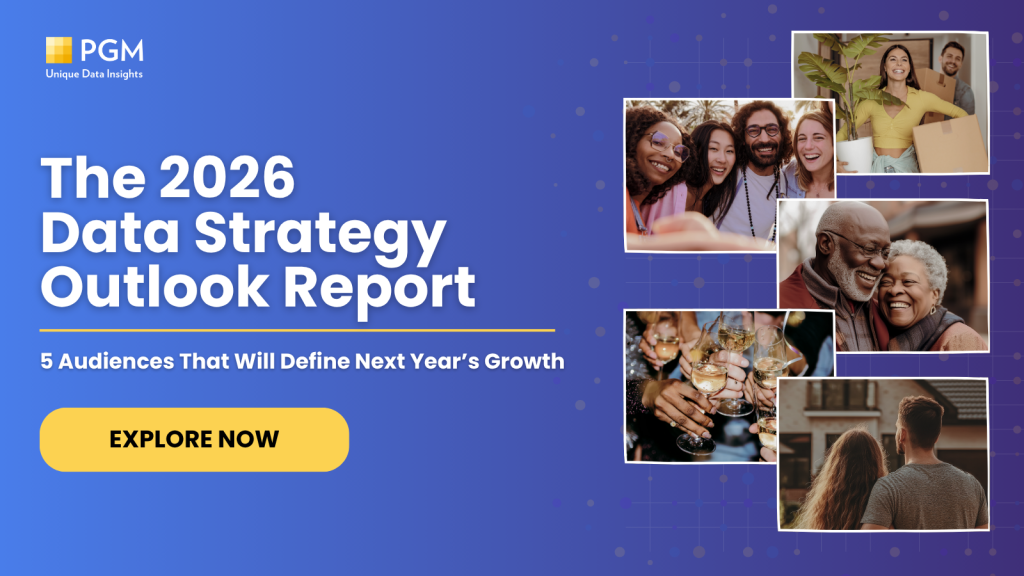Understanding and connecting with your target audience through personalized communications is vital for success. Audience segmentation, the process of dividing your customer base into distinct groups based on specific criteria, is a powerful strategy to achieve this personalization.
By personalizing your marketing efforts to the unique needs and preferences of each segment, you can create more relevant and engaging campaigns, driving higher customer engagement and ultimately, better business results.
In fact, a report by Mckinsey & Company found that 78% of consumers are more likely to make repeat purchases from brands that personalize their messages. In addition, nearly 80% are also more likely to refer their family and friends to these companies.
Audience Segmentation Examples
Here are 12 audience segmentation examples and how to put segmented messaging into action.
1. Demographic Segmentation
Grouping audiences by age, gender, income, education, and other demographic factors allows you to target specific consumer groups.
Example: Fitness apparel brand targeting women aged 30 to 45 who are health-conscious and have a moderate to high income.
By identifying this specific demographic, the brand can personalize its marketing efforts to meet the preferences and needs of this group. They might create advertisements featuring active and fit women in this age range, use messaging that emphasizes the importance of quality and performance in their products, and promote products that align with their target audience’s fitness goals and lifestyle.
2. Geographic Segmentation
Segmenting audiences based on their location helps you customize marketing efforts for regional preferences and needs.
Example: Beverage retailer company personalizing marketing strategies based on regional preferences and climate variations.
In colder regions, they might focus on promoting hot beverages like coffee and tea, emphasizing the comforting and warming aspects of their products. In warmer regions, they may highlight refreshing and cooling beverages like iced tea or fruit juices, focusing on the thirst-quenching properties.
3. Psychographic Segmentation
Analyze audience interests, values, lifestyles, and behaviors to connect with customers on a deeper emotional level.
Example: Travel company targeting adventure enthusiasts.
Instead of solely focusing on demographics like age or income, the company identifies a specific psychographic group – individuals who are adventurous, thrill-seekers, and enjoy adrenaline-pumping experiences.
To cater to this segment, the travel company might offer adventure-based vacation packages, such as hiking trips to remote locations, white-water rafting adventures, or wildlife safaris. They could also tailor their marketing messages to highlight the excitement, challenge, and unique experiences that appeal to this group of travelers.
4. Behavioral Segmentation
Segmenting based on past actions and interactions with your brand provides insights into buying patterns and preferences.
Example: Home goods retailer targeting customers who are frequent purchasers.
The store identifies customers who make frequent purchases and places them in a special segment. As part of the program, these loyal customers receive exclusive discounts, special promotions, or early access to new product launches. The store uses this behavioral segmentation strategy to incentivize repeat business and foster customer loyalty.
5. Customer Lifecycle Stage Segmentation
Personalize your messages based on where customers are in the buying journey or customer lifecycle.
Example: online subscription service targeting customers based on where they are in their customer journey.
Prospective Customers: Individuals who have shown interest in the subscription service but have not yet made a purchase might receive a limited-time discount to encourage them to convert into first-time customers.
First-time Customers: Consumers who have recently signed up and made their first purchase or subscribed to the service might receive a welcome message and FAQ to help them make the most of the service.
Active Customers: Customers who have been using the service regularly and making repeat purchases may be rewarded with loyalty points or personalized recommendations based on their usage patterns.
Churned Customers: Former customers who have canceled their subscriptions or stopped using the service might receive win-back offers or targeted surveys to understand the reasons behind their decision to leave.
6. Purchase Intent Segmentation
Target audiences showing high purchase intent to offer relevant products and incentives.
Example: Travel booking website that implements purchase intent segmentation to optimize its marketing efforts.
Through analysis of user behavior on their platform, the website identifies three distinct segments: “Ready-to-Book Travelers,” “Browsing Explorers,” and “Hesitant Vacationers.”
Ready-to-Book Travelers: This segment consists of users who have visited the website multiple times, searched for specific destinations, and added travel dates to their search. To encourage immediate bookings, the website targets this segment with personalized offers, such as limited-time discounts or free upgrades.
Browsing Explorers: These are users who have shown interest in various travel destinations but have not taken any concrete action. To convert this segment into bookings, the website retargets them with captivating destination-focused content and promotions.
Hesitant Vacationers: The segment consists of users who have viewed travel options but have not taken any further action. The website nurtures this segment with informative content, user reviews, and testimonials to build trust and address any concerns.
7. Customer Value Segmentation
Segment customers by their lifetime value to prioritize high-value clients for special treatment and loyalty programs.
Example: Subscription-based software company uses customer value segmentation to cater to different tiers of customers based on their spending and engagement.
The company classifies its customers into three segments: “Basic Users,” “Premium Subscribers,” and “Enterprise Clients.”
Basic Users: These are customers who are on the free plan or have made minimal purchases. The company focuses on nurturing this segment through targeted educational content and periodic promotional offers to encourage them to upgrade to a paid plan.
Premium Subscribers: These are customers who have subscribed to the company’s premium plan. For this segment, the company offers personalized customer support, advanced features, and early access to new updates to enhance their overall experience.
Enterprise Clients: These are high-value customers with complex needs and substantial spending. The company assigns a dedicated account manager and offers personalized solutions to address their specific requirements.
8. Competitive Analysis Segmentation
Analyze competitors’ audience segmentation to identify gaps and opportunities in the market.
Example: Sportswear brand uses a competitive analysis segmentation to identify segments based on their competitive landscape.
The company identifies “Athletic Performance Enthusiasts” and “Budget-Conscious Fitness Seekers.”
Athletic Performance Enthusiasts: The brand conducts in-depth research on its competitors’ top-performing products and focuses on featuring their innovative, high-performance activewear to meet the demands of this segment.
Budget-Conscious Fitness Seekers: The brand conducts pricing analysis to offer affordable yet quality fitness wear options that rival competing brands in terms of value for money.
9. Offline Interactions Segmentation
Leverage the offline interactions segment based on how audiences interact with your brand at physical stores or events.
Example: A large clothing brand creates a segment of its in-store shoppers.
The retailer sends communications inviting in-store customers to exclusive events or offering special in-store discounts. By identifying and segmenting loyal customers who visit brick-and-mortar locations, the retail store can create a VIP program that grants access to exclusive events such as product launches, private shopping experiences, or customer appreciation nights. Additionally, the store can offer personalized discounts or promotions to reward frequent shoppers and encourage repeat visits.
10. Customer Needs Segmentation
The customer needs segment addresses specific needs, pain points, and challenges faced by each audience segment.
Example: A healthcare company may segment its customers based on the specific interests and needs of various groups including: “Patients with Chronic Conditions,” “New Parents,” and “Senior Citizens.”
Patients with Chronic Conditions: The healthcare company focuses on providing comprehensive disease management solutions and personalized support to alleviate their daily health struggles.
New Parents: The healthcare company offers products and services catered to the unique needs of parenting, like baby care workshops and pediatrician consultations.
Senior Citizens: The healthcare company develops specialized care plans, considering age-related health concerns and mobility challenges.
11. Purchase History Segmentation
The purchase history segment relies on data to analyze past purchases in order to offer personalized recommendations and promotions.
Example: Beauty and skincare retailer segments customers into groups based on their previous purchases, including the specific products they’ve bought and the frequency of their purchases.
Using purchase data, the retailer creates segments for “Skincare Enthusiasts” and “Makeup Lovers.”
Skincare Enthusiasts: The retailer offers personalized recommendations for skincare products that address their specific skin concerns and preferences. They might receive targeted promotions on serums, moisturizers, and other skincare essentials that align with their skincare routine.
Makeup Lovers: The retailer provides personalized recommendations for makeup products, such as eyeshadows, lipsticks, and foundation shades that match their preferred looks and styles. They might also receive special offers on new makeup releases and limited-edition collections.
12. Moving Customers Segmentation
The moving customers segment targets consumers who are moving to a new home. With more than $11,000 on average spent per move, new movers present a major opportunity for brands.
Example: A home improvement retailer targets pre-movers and new movers.
The home improvement retailer targets consumers who have listed their home for sale and newly moved individuals with information such as a catalog of home improvement products, a discount or coupon for their first purchase, and a guide on popular renovation ideas and tips. The package may also include information about the retailer’s installation services and DIY workshops.
Conclusion
Creating effective marketing audiences requires a thoughtful and data-driven approach. Remember, audience segmentation is an ongoing process that requires continuous analysis and optimization to ensure the success of your marketing campaigns. With the right strategies in place, you can connect with your audience on a deeper level, driving better engagement and achieving your marketing goals.






